Cotton
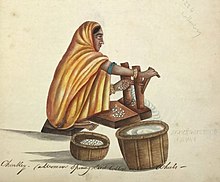
Cotton is a soft, fluffy staple fiber that grows in a boll, or protective capsule, around the seeds of cotton plants of the genus Gossypium. The fiber is almost pure cellulose. Under natural conditions, the cotton bolls will tend to increase the dispersion of the seeds. The plant is a shrub native to tropical and subtropical regions around the world, including the Americas, Africa, and India.
Quotes[edit]
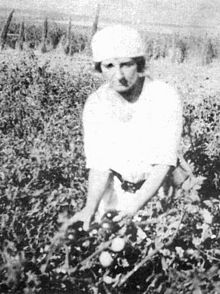
- Ahmedabad reputed as the 'Manchester' of western India, is a busy industrial city situated in a cotton-growing hinterland north of the Gulf of Cambay...
- World Bank studies suggest that US subsidies alone reduce West Africa's annual revenue from cotton exports by $250 [million] a year.
- World Bank, in Growing Rese ntment Against Taxes?, Watch Tower Bible and Tract Society of Pennsylvania, 2003
- On the contrary, the invention of the cotton gin and mechanical spinning machines actually reinforced the archaic and brutal institutions of slavery in the Old South.
- Dr. Richard Barbrook, in Global Algorithm 1.5: Hypermedia Freedom, University of Westminster, London.

- Buying good sheets. Thread count is actually a lie. Just because a thread count is 1,500 on a set of sheets doesn’t mean that they’re well-made sheets. Truly, the quality of the cotton and the quality of the way something is woven is much more important than thread count. Some of the best sheets I’ve ever slept on are 500 thread count, and they’re much softer than 1,500, 1,200 because they’re nicer cotton and they’re woven tightly. So, buy yourself a good pair of sheets, buy yourself a simple upholstered headboard in gray or camel or black. And start simply. You know, let your personality shine through as you continue to decorate.
- Nate Berkus, in Nate Berkus Interview, AskMen (AM)
- An instrument of torture operated by a person with cotton in his ears. There are two instruments that are worse than a clarionet– two clarionets.
- Ambrose Bierce, in Tom Cutler A Gentleman's Bedside Book: Entertainment for the Last Fifteen Minutes of the Day ., Constable & Robinson, 30 September 2010,
- Moreover, some of the biggest planning disasters in the world occurred in Soviet agriculture, notably with cotton production in Soviet Central Asia, a sphere in which rampant corruption, and the serious misreporting of production statistics, vied with fundamental environmental degradation not least due to excessive irrigation that caused the exhaustion of the Aral Sea. These problems were a major issue for Mikhail Gorbachev who, in the early 1980s, was the Politburo member responsible for agriculture. Environmental issues included the whisking into the air, as injurious dust, of dried out soil contaminated by chemical fertilisers. This led to an increase of birth defects among Uzbek and Turkmen children. The children living in eastern Kazakhstan were afflicted with such horrors due to the aftermath of nuclear bomb tests.
- Jeremy Black, The Cold War: A Military History (2015)
- Summer time, an' the livin' is easy,
Fish are jumpin', an' the cotton is high.
Oh, yo' daddy's rich an' yo' ma is good-lookin',
So hush, little baby, don't yo' cry.- Heward Du Bose, in Dictionary of Quotations, Wordsworth Editions, p. 169
- Possibly you are not aware of the fact that the largest sum given by any contributor to the fund is but a trifle when compared with the losses suffered by nearly all the firms in the cotton trade during the disastrous years of the American war.
- John Bright, in The public letters of John Bright, S. Low, Marston, Searle & Rivington, 1885, p. 119

- King Cotton, phrase frequently used by Southern politicians and authors prior to the American Civil War, indicating the economic and political importance of cotton production. After the invention of the cotton gin (1793), cotton surpassed tobacco as the dominant cash crop in the agricultural economy of the South, soon comprising more than half the total U.S. exports.
- The Editors of The Encyclopædia Britannica, in King Cotton, Encyclopædia Britannica, Inc., 16 January 2014
- To the detriment of the entire region, the South continued after the war to be a one-crop economy until the 20th century, when the New Deal and World War II encouraged diversification and industrialization
- The Editors of The Encyclopædia Britannica, in "King Cotton".
- Could you believe it possible that through such a night as this they choose to sleep under those wadded cotton coverlets, and dread not instantaneous asphyxiation?
- Richard Francis Burton, in Goa And The Blue Mountains, Penguin Books India, 2003, p. 7

- All work, even cotton spinning, is noble; work is alone noble.
- Thomas Carlyle, in CLEP Western Civilization II: The Best Test Preparation for the CLEP, Research & Education Association, 30 November 2005, p. 33
- Whenever anyone who takes a scientific interest in cotton growing, or in the natural history of this part of the world, comes to visit Tuskegee, he invariably seeks and consults Professor Garver.
- George Washington Carver, in Booker T. Washington The Booker T. Washington Reader (an African American Heritage Book), ilder Publications, 1 January 2008, p. 213
- But tomorrow, dawn will come the way I picture her,
barefoot and disheveled, standing outside my window
in one of the fragile cotton dresses of the poor.
She will look in at me with her thin arms extended,
offering a handful of birdsong and a small cup of light.- William Collins, in Diane Boller, Don Selby, Chryss Yost Poetry Daily: 366 Poems from the World's Most Popular Poetry Website, Sourcebooks, Inc., 1 December 2003, p. 199
- Finally, that I may compress in a few words the brief account of our departure and quick return, and the gain, I promise this, that If I am supported by our most invincible sovereigns with a little of their help, as much gold can be supplied as they will need, indeed as much of spices, of cotton, of mastic gum (which is only found in w:ChiosChios),
- Christopher Columbus, in Translation The Columbus Letter (Basel, 1494), Osher Map Library, University of Southern Maine.
- ...the evil of it is, that it is a world wrapped up in too much jeweller's cotton and fine wool, and cannot hear the rushing of the larger worlds, and cannot see them as they circle round the sun. It is a deadened world, and its growth is sometimes unhealthy for want of air.
- Charles Dickens, in Bleak House, Bradbury and Evans, 1853, p. 6
- ...cooperative effort among nations, can be fortified, not by weapons of war but by wheat and by cotton, by milk and by wool, by meat and timber and rice.
- Dwight D. Eisenhower, in [http://books.google.co.in/books?id=-k7nJOuWwKsC&pg=PA29 Recipe for Peace Now: Reach Out, Encourage, Connect, Inspire, Progress, Eat], AuthorHouse, 1 September 2009, p. 29
- Cotton has been spun, woven, and dyed since prehistoric times. It clothed the people of ancient India, Egypt, and China. Hundreds of years before the Christian era, cotton textiles were woven in India with matchless skill, and their use spread to the Mediterranean countries.

- Where white men rent farms and live like niggers and niggers crop on shares and live like animals, where cotton is planted and grows man-tall in the very cracks of the sidewalks...
- William Faulkner, in Edouard Glissant Faulkner, Mississippi, University of Chicago Press, 15 June 2000, p. 120
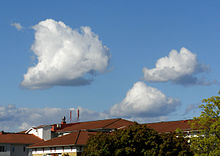
- Aren't the clouds beautiful? They look like big balls of cotton. I could just lie here all day and watch them drift by.
- Len Fisher, in The Perfect Swarm: The Science of Complexity in Everyday Life, ReadHowYouWant.com, Limited, 1 May 2010, p. 192
- Gone are the days when my heart was young and gay,
Gone are my friends from the cotton fields away, ,
Gone from the earth to a better land I know,
I hear their gentle voices calling “Old Black Joe”.- Stephen C. Foster, in Heywood and Son's Up-to-date Collection of Nigger Songs and Recitations, Heywood & Son, 1865, p. 6


- The Cotton Mill invented in England, within the last twenty years forms an item of great importance in the general mass of national industry….To this invention is to be attributed essentially the immense progress, which has been so suddenly made in Great Britain in the various fabrics of cotton.
- You dare not make war upon cotton! No power on earth dares make war upon it. Cotton is king.
- James H. Hammond (1854), in The Editors of The Encyclopædia Britannica, in "King Cotton".
- ...and he stuck a bit of cotton on the second wound. With each stroke of the razor, another bit of cotton joined the crop sprouting on the Hoca’s left cheek, “Now”, said the barber, “I will do the other side”.
- Nasreddin Hoca, in Barbara K. Walker The Art of the Turkish Tale, Volume 1, Texas Tech University Press, 1990, p. 57
- And you prate of the wealth of nations, as if it were bought and sold,
The wealth of nations is men, not silk and cotton and gold.- Richard Hovey, in Wealth, Hoyt’s New Cyclopedia of Practical Quotations. 1922
- Platero is a small donkey, a soft, hairy donkey: so soft to the touch that he might be said to be made of cotton, with no bones. Only the jet mirrors of his eyes are hard like two black crystal scarabs. I turn him loose, and he goes to...
- Juan Ramón Jiménez,in Platero and I, University of Texas Press, 1957, p. 3
- In Georgia where children work day and night in the cotton mills they have just passed a bill to protect song birds. What about the little children from whom all song is gone?
- Mary Harris Jones, in Working in America, Infobase Publishing, 1 January 2007, p. 210
- Mao is a sometime Yin sometime Yang strange man, he has a soft-as-cotton outer layer, but at the same time has sharp needles hiding inside...I do not think he could achieve anything, at the end he will be crushed inside my palm.
- Chiang Kai-shek, in Chiang Kai-shek, Eigen—Arnett Educational & Cultural Foundation Inc.
- Over money and religion there's more blood to spill. The wounds of slaves in cotton fields that never heal, what's the deal?
- Talib Kweli, in Thieves in the Night Lyrics, The Rap Map
- I am carrying so much cotton that I can't sleep thinking about it. It is wearing me out. What can I do?
- Edwin Lefèvre, in Reminiscences of a Stock Operator, John Wiley & Sons, 10 April 2012, p. 115
- Without slavery there is no cotton; without cotton, there is no modern industry. It is slavery that has given value to universal commerce, and it is world trade which is the condition of large scale industry.
- Karl Marx, in Craig Calhoun Sociology in America: A History, University of Chicago Press, 15 September 2008, p. 524
- We [Americans] never really did have a real sense of humor. Not satire, anyway. We're a fatheaded, cotton-picking society. When we realize finally that we aren't God's given children, we'll understand satire.
- Bill Mauldin, in Freedom & Union, Volumes 17-18, Federal Union, 1962, p. 12
- We hate war. We do not rejoice in victories. We rejoice when a new kind of cotton is grown, and when strawberries bloom in Israel.
- Golda Meir, in As good as Golda: the warmth and wisdom of Israel's Prime Minister, McCall Pub. Co., 1 January 1970, p. 28
- Production of Khadi included cotton growing, picking, ginning, cleaning, carding, slivering spinning, sizing, dyeing, preparing the warp and woof, wearing and washing. Gandhi's plea for Khadi was also intended to serve as a base for many village industries such as hand grinding, hand pounding, soap making.
- O. P. Misra, in Economic Thought of Gandhi and Nehru: A Comparative Analysis, M.D. Publications Pvt. Ltd., 01 January 1995
- We come and go. Asa di Var: Make compassion the cotton, contentment the thread, modesty the knot and truth.
- Nanak, in Asa Di Var, sfussa.com

- That hard work included picking cotton at age seven in the rows beside Mama Nelson. Picking cotton is hard and painful work, and the most lasting lesson I learned in the fields was that I didn't want to spend my life picking cotton.
- Willie Nelson, in The Tao of Willie: A Guide to the Happiness in Your Heart, Penguin, 9 May 2006, p. 25
- I used to work in the cotton fields a lot when I was young. There were a lot of African Americans working out there. A lot of Mexicans - the blacks and the whites and the Mexicans, all out there singing, and it was like an opera in the cotton fields, and I can still hear it in the music that I write and play today.
- Willie Nelson, in Michael Hann Willie Nelson: 'If we made marijuana legal, we'd save a whole lotta money and lives', The Guardian, 17 May 2012
- Every day before supper and before we went to services on Sundays may grandmother would read the Bible to me and my grandfather would pray. We even had devotions before going to pick cotton in the fields. Prayer and the Bible, became a part of everyday thought and beliefs. I learned to put my trust in God and seek Him as my strength.
- Rosa Parks, in G. Scott Cady, Christopher L. Webber Year with American Saints, Church Publishing, Inc, p. 367
- You might on moral and social grounds prefer cornfields to cotton factories, an agricultural to a manufacturing population.
- Robert Peel, in L. W. B. Brockliss, David Eastwood A Union of Multiple Identities: The British Isles, C.1750-c.1850, Manchester University Press, 1997, p. 33
- I say, there came to my ears a low, dull, quick sound, such as a watch makes when enveloped in cotton. I knew that sound well, too. It was the beating of the old man's heart.
- Edgar Allan Poe, in John W. Robertson Edgar A. Poe: A Study, Ardent Media, 1970, p. 309
- Before the Civil War, the Southern states were selling a lot of cotton to England and didn't seem to mind British occupation. By and large, the Revolutionary War wasn't at all great for business.
- Henry Rollins, in Rebelling in Sweethome Alabama, L.A.Weekly,
- ...that we manufacture everything there except men; we blanch cotton, and strengthen steel, and refine sugar, and shape pottery.
- John Ruskin, in The Genius of John Ruskin: Selections from His Writings, University of Virginia Press, 1964, p. 180
- O Nanak, the shaven-headed ones are devils. They are not pleased to hear these words. When it rains, there is happiness. Water is the key to all life. When it rains, the corn grows, and the sugar cane, and the cotton, which provides clothing for all.
- Sri Guru Granth Sahib, in Marilynn Hughes he Voice of the Prophets: Wisdom of the Ages, Volume 2 of 12, Lulu.com, 1 November 2005, p. 223
- There is the illusion of "increased command over Nature," meaning that cotton is cheap and that ten miles of country road on a bicycle have replaced four on foot.
- George Bernard Shaw, in Caesar and Cleopatra, The Floating Press, 1 June 2011, p. 154

- I only had to recall the previous winter in the cabin, when we had only cotton blankets, and had rags on top of us.
- Upton Sinclair, in Anthony Fellow American Media History, Cengage Learning, 1 January 2012, p. 188
- In the cotton States, after the war, the simple and ignorant w:NegroesNegroes made the crops for the white planter on shares.
- Mark Twain, in How to Tell a Story and Other Essays, Digireads.com Publishing, 1 January 2004, p. 109
The Biology of Gossypium hirsutum L. and Gossypium barbadense L. (cotton) Version[edit]
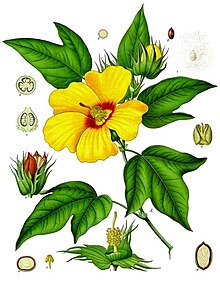
The Biology of Gossypium hirsutum L. and Gossypium barbadense L. (cotton) Version. The Australian Government Office of the Gene Technology, 2 February 2008
- In nature, G. hirsutum and G. barbadense are perennial shrubs. However, in the agricultural system both species are cultivated as annuals, with destruction of plants after harvesting the fruit for seed and fibre. The plants are mainly grown for their fibre, cotton lint, which is used in textiles and clothing.
- p.1
- Gossypium hirsutum L. was named due to its hairiness (hirsute), although it has also been referred to as Gossypium hirsutum ssp. latifolium, Gossypium hirsutum var. punctatum, Gossypium jamaicense, Gossypium mexicanum, Gossypium morrillii, Gossypium punctatum, Gossypium purpurascens, Gossypium religiosum, Gossypium schottii, Gossypium taitense and Gossypium tridens. It is commonly known as upland cotton, American cotton or Mexican cotton.
- p.1
- G. barbadense L. was named after its assumed habitat of Barbados. It has been known by alternative scientific names as Gossypium evertum, Gossypium peruvianum, Gossypium vitifolium and Gossypium brasiliense (USDA 2006). It is commonly known as Creole cotton, Egyptian cotton, extra long-staple or ELS cotton, Indian cotton, Sea Island cotton or [[w:Pima cotton|Pima cotton.
- P.1
- Archaeological records indicate that Gossypium fibre has been used since 6000 BC. A Gossypium thread, used to string copper beads, from w:MehrgarhMehrgarh in Pakistan has been dated at 6th millennium BC.
- C. Moulherat, et al.,(2002).), in P.5
- Cotton is currently the leading plant fibre crop worldwide and is grown commercially in the temperate and tropical regions of more than 50 countries.
- W.C.Smith (1999), in p. 6
- It is estimated that cotton is cultivated on approximately 2.4% of the World’s arable land.
- D.Blaise (2006), in p. 6
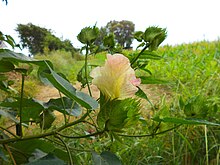


- Specific areas of production include countries such as USA, India, China, America, the Middle East and Australia, where climatic conditions suit the natural growth requirements of cotton, including periods of hot and dry weather and where adequate moisture is available, often obtained through irrigation.
- In P.7
- Cotton is primarily grown as a fibre crop. It is harvested as ‘seed cotton’ which is then ‘ginned’ to separate the seed and lint. The long ‘lint’ fibres are further processed by spinning to produce yarn that is knitted or woven into fabrics. Cotton fabrics, used in clothing, upholstery, towels and other household products, are made from cotton lint.
- In P.7
- De-linted cotton seed (ie. seed with no lint or linters) is processed into oil, meal and hulls.
- J.P.Cherry, H.R.Leffler (1984), in P.7
- The processing of cotton seed oil involves a series of steps including heating, addition of sodium hydroxide, bleaching with clay, filtering and treating with steam under vacuum.
- OECD (2004), P.7
- Cotton seed oil has been in common use since the middle of the nineteenth century and achieved GRAS (Generally Recognised As Safe) status under the United States Federal Food Drug and Cosmetic Act because of its common use prior to 1958 (ANZFA 2002). It is used in a variety of products including edible vegetable oils and margarine, soap, and plastics.
- A.W.Frank (1987), P.7-8
- Cotton trash can be used as a bulking agent to improve the efficacy of animal manure composting. There has also been some interest in using cotton waste to ferment to produce ethanol.
- T.Jeoh, F.A.Agblevor (2001), P.8
- Extracts from cotton plants, which would be primarily gossypol, have been used as a medicine. In traditional medicine G. barbadense leaves have been used as a treatment for nausea during pregnancy or for ‘proud flesh’ (swollen tissue around a wound).
- W.H.Sawyer (1955), p. 8
- G. barbadense extracts are still sold for treatment of hypertension, fungal infection and menstrual stimulant.
- Tropilab Inc (2007), p. 8
- More than 1326 species of insects have been reported in commercial cotton fields worldwide but only a small proportion are pests.
- G.A.Matthews, J.P. Tunstall (1994), p. 41
- Cotton is infected by a range of diseases which can affect the quality of the fibre and seed, as well as the yield and cost of production of the cotton crop.
- A.A.Bell (1999), P.44
2009 International Year of Natural Fibres[edit]
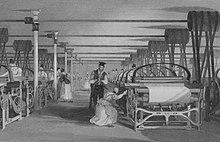
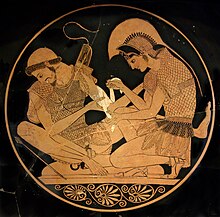
[http://www.naturalfibres2009.org/en/fibres/cotton.html 2009 International Year of Natural Fibres] Natural fibres -Cotton]
- Cotton is almost pure cellulose, with softness and breathability that have made it the world's most popular natural fibre.
- Almost pure cellulose, cotton is the world's most widely used natural fibre and still the undisputed "king" of the global textiles industry.
- The world produces around 25 million tonnes of cotton every year. Six countries - China, Brazil, India, Pakistan, the USA and Uzbekistan - account for more than 80% of total production.
- It is made into specialty materials suitable for a great variety of applications: fire-proof apparel, cotton wool, compresses, gauze bandages, sanitary towels and cotton swabs. Industrial products containing cotton include book bindings, industrial thread and tarpaulins.
- An estimated 60% of cotton fibre is used as yarn and threads in a wide range of clothing, most notably in shirts, T-shirts and [w:Jeans|jeans]], but also in coats, jackets, underwear and foundation garments.
Gandhi's peaceful spin[edit]


Eliza Drummond, in Gandhi's peaceful spin, Spinners’ Quarterly.
- It was the late 1920s when Gandhi proposed his plan to liberate India from British rule, creating swaraj or self-rule, through the use of the spinning wheel. He believed that if Indians would spin their own cotton to make cloth called khadi instead of buying British-made cloth, they could become self-sufficient. Although Gandhi's spinning campaign was born out of a desire to liberate his people from the oppression of foreign rule and an equally oppressive caste system, he soon grew to recognize that spinning promoted "the education of becoming and being.
- I find spinning to be immediately centering and calming. I use wheels to produce quantity, but vastly prefer handspindles, and often carry one with me to spin in odd moments. The spindle shaft is the center pole, the world tree. The whorl endlessly revolves--time, earth, generations--constantly moving, but never going anywhere. Individual fibers appear, become one in the thread, and disappear into the cop. Constantly appearing and going on, yet there is seemingly no change, the point of draft is changeless--a continual coming and going. My hands move as hands have moved for tens of thousands of years, as they do now, as hands will. And so it is.
- I often spin to replenish my energy. And I am not alone. Women and men all over North America sit daily at their wheels, spending time, as Gandhi would have wished, in quiet contemplation.
A Luxurious and Political Fiber[edit]


Wickham Boyle, in [http://handeyemagazine.com/content/india-and-history-cotton A Luxurious and Political Fiber
- Cotton [is] truly a miracle fiber: it has been spun, woven, and dyed since ancient times, and it is still the most widely used fiber for cloth today. It is soft and fluffy and grows in a boll around the seeds of the cotton plant. There is almost nothing that cotton can’t be turned into: clothes, bedding, tabletop, furniture, even art.
- The first people in Eurasia to grow cotton for clothing, sheets, and towels were the Harappan people, an early civilization, who migrated from Africa to what is now modern Pakistan.
- Information about cotton are mentioned in a series of famous Indian poems written in 600 BC called the Rigveda — one of the most sacred texts of Hinduism.
- In India there were trees growing wild, which produce a kind of wool better than sheep’s wool in beauty and quality, which the Indians use for making their clothes. During this period, the famous Ajanta Cave carvings show innovative cotton growers in India had invented an early roller machine to get the seeds out of the cotton.
- Herodotus, wrote in 400 BC
- By the Guptan period, circa 200 AD, the Indians were selling cotton as a luxury good to their neighbors in the east and west — the Chinese and the Parthians. Further west, the Roman considered cotton as luxurious and as expensive as silk, which they bought from Arabic or Parthian traders. Like Herodotus, the Roman author and philosopher Pliny wrote that in India there were, "trees that bear wool" and "balls of down from which an expensive linen material for clothes is made."
- The establishment of the Islamic Empire in the late 600’s AD spread cotton production westward across the Middle East to North Africa and Spain.
- Remarkably, very little cotton cloth was imported to England before the 15th century and the small amounts that had been imported were used chiefly for candlewicks. In the 1600s throughout the entire tale of gods and animals, cotton has a role within the story. In India today, as it was for thousands of years, no matter what caste you occupy or what job you hold you will be wearing a cotton garment, either elaborately adorned or a plain.
- The rise of Mahatma Gandhi empowered the people of India. Gandhi and his followers were angered by the laws that sent local Indian cotton back to Britain to be milled into cloth, and then sent back to India in which the people were forced to purchase British loomed cotton rather than hand woven khadi. Gandhi saw the revival of local village economies as the key to India's spiritual and economic regeneration and he envisioned homespun khadi as the catalyst for economic independence. He built his strategy around the revival of traditional craftsmanship and skills that would feed local demand with local production. As part of Gandhi’s policies of civil disobedience and non-cooperation, he encouraged people to boycott British goods, specifically cotton textiles, and encouraged Indians to use homespun and woven khadi. In India, he adopted the charka or spinning wheel as the symbol of his principle of self-sufficiency.
- In modern, independent India, the cotton industry could, once again, compete on the world market. There is a still great diversity in the traditions and methods used to produce Indian cotton. Weavers often work in close family structures where ancient skills are passed from generation to generation and there is a great pride in the work, the fiber and the rich history surrounding even the most simple cotton fabric.
- The khadi people made in home workshops and small-scale factories supplemented the small incomes they earned toiling in the fields. Gandhi used khadi as the uniform for the first Non Cooperation movement and the Gandhi cap symbolized the Indo-British battle over the looms of Manchester and a bid for a modern Indian identity.

